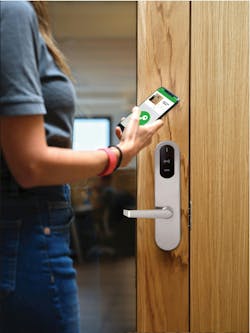The Skinny:
-
Smart locks are gaining widespread adoption across verticals like education, multifamily, and healthcare.
-
Mobile and biometric access are transforming credential management, with mobile phones increasingly replacing physical keys and facial recognition emerging as a high-security alternative.
-
Retrofit and cloud capabilities make deployment faster and easier, allowing integrators to upgrade doors with minimal disruption and offer value-added services like remote access, audit trails, and automation.
This article originally appeared in Access Control Trends & Technology 2025, a special bonus publication to Security Business magazine and Security Technology Executive.
Once thought of as expensive hi-tech deadbolts, smart locks are now living up to their promise of providing convenience, connectivity and scalability, all while giving security professionals more options to offer at the door, and end users more opportunities to get their return on investment – and then some.
As smart lock manufacturers continue to evolve and offer new and creative retrofit options for facilities looking to upgrade their older mechanical locks, the industry is seeing strong early adoption across many verticals such as education, healthcare and multifamily.
“In 2024, IDEMIA released their access control market report, and it showed for the first time that smart locks, as opposed to a wall reader, are now 51% of the total access market,” says Bill Wood, president, North America, Salto, who points out that much of that growth is in the residential segment, both single-family home and multifamily.
“When we think about where we see adoption today, the top markets are very focused around the end user journey, and they are prioritizing the experience of the cardholder or the credential holder more than any other attribute in their choice or selection of smart locking technology,” he says.
Education, hospitality and multifamily are all embracing smart locks and advanced technology like biometrics to streamline that user experience while providing more control and management capabilities.
“Those three markets all have one thing in common because in some aspects of their businesses, there is some kind of lodging experience behind the scenes,” Wood explains. “On a college campus, it's student housing, in multifamily residential, it's the tenant, and in hospitality, it's the guests at the hotel room. And we also see great promise in healthcare, which is traditionally very focused around compliance. Still, as the healthcare market is decentralizing away from the hospital setting, the customer journey is becoming more and more important.”
Adding Value Beyond the Door
As end users begin to ask for smart locking technology, the added value that a smart lock platform can bring far outweighs any initial investment.
“Some of that value comes across differently in each of the vertical markets,” says Brian Telljohann, director of Product Management, Allegion. “With multifamily, for example, migrating to electronic access control with a credential now provides both enhanced security and convenience. Tenants with the credentials don't have to worry about losing the brass key, and you can take advantage of additional features that incorporate automation and remote lock management.”
From an audit trail to providing property managers with remote management and control, often through a cloud-based software platform, there is much that can be achieved as smart locking technology continues to evolve.
“You're adding value and services that come together in a more integrated way, so if you are doing package delivery, or self-touring, or tenant amenities, for example, they are all baked into this enhanced user or tenant experience, which also translates into being able to charge a higher rent,” Telljohann points out. “And that's why we're seeing such a nice adoption in that multifamily market and now in the institutional market, as some of the same values apply, but it's more about scalability and providing credential management security. As you have a large population of users, that could be in the thousands to tens of thousands.”
As key management becomes cumbersome, “credentials and a credential system that’s centrally managed is a lot more elegant and it saves time and convenience for rekeying,” he adds. “In addition, the integration of the access control platform into a building automation system of large commercial buildings has a lot of value as well to the building owner.”
As Wood points out, with the emergence of electronic access control and cloud-based technology, you don't need any on-premises infrastructure other than an internet connection to make a smart locking system work.
“I like to talk to people about the aluminum storefront door, and that's something that every locksmith feels and addresses for their customers practically every day,” says Wood, noting that in the past converting that aluminum front door would require long hours, drilling and a disruption to the customer, not to mention any issues that may arise during or after the installation process.
“Now I can just simply remove a cylinder, put in an electronic cylinder and I still have the same manual functionality, but now I'm doing it with an electronic key instead of a mechanical key and I have an audit,” he explains. “And in about an hour and a half, any good locksmith can convert that aluminum storefront door to a battery-operated one that now has scheduled functions beyond just being a card reader, plus audit. And if you connect that up to what we refer to as an IQ bridge to get it to the Internet, you can have a cloud-based operating system that's up and running on that single door in less than a couple of hours.”
With all this technology being leveraged, a locksmith can save considerable money per door while providing additional value propositions that can help make the customer stickier and bring in more recurring revenue.
Mobile First Mentality
Any discussion about smart locks leads to a broader conversation about mobile access, biometrics, and cloud-based technology. While there are some barriers to adoption within specific verticals, mobile adoption continues to proliferate in college and university settings, as well as in multifamily and healthcare.
“The benefit of the mobile credential is the convenience, so that is outweighing some of these barriers and allowing people to still pursue and decide to upgrade their hardware when necessary to obtain that user experience,” says Telljohann. “Universities are a good example, as students expect everything to be on their mobile device.”
Olivia Renaud, Allegion’s group product manager for credentials, agrees that adding mobile credentials when selling locks and readers enhances the overall user experience, while broadening what is possible around the door.
“Inherently, mobile credentials force sites and customers to adapt to a single credential technology,” she explains. “Once a school decides that they want to move toward the mobile journey, it makes it more viable to add additional use cases to their ecosystem, such as electronic locks. Oftentimes, it’s the jumping off point to understand the breadth that mobile credentials can offer and starts customers down that journey to expand their use with physical readers and locks.”
Renaud sees a continued proliferation of mobile credentials. “The existing standards and products (e.g., Mifare Desfire) that are driving transition to mobile today, as well as future standards and products (e.g., Aliro), will continue to drive that transition to mobile, including in places where it may not be viable for symmetric credentials to exist,” she says.
Biometric Adoption
All agree that a natural extension of the smart lock is the potential use of biometrics, with facial recognition leading the charge.
“I certainly do think that biometrics will continue to play a role in the access control environment,” says Telljohann. “Where I see the most growth is in identity management, such as at airports with TSA, where you're focused on validating your identity. When it comes to access, certainly, there are use cases where biometrics can be handy. I think its benefits are primarily around touchless interactions, and using facial recognition is a high-growth area. And they can be very valuable also for secondary authentication for very high security applications, whether that's government or sensitive university spaces.”
Wood agrees that the phone and biometrics are critical elements in any modern access environment, either as the credential itself or as a tool to help validate an individual's identity.
“The idea of eliminating the need for a physical credential from certain applications we see as a real enabler, especially in applications where maybe mobile isn’t the best option or solution or the most applicable credential,” he says. “We've launched external to North America our first facial recognition reader because I think in the same way the mobile device has pushed out many of our legacy physical credentials for that convenience factor, face is going to push out some aspect of additional credentials, be it mobile or physical, for the convenience factor of being able to just walk up to an opening, have it recognize and identify you and allow for that seamless entry.”
He continues, “In the mobile world, you can use a trusted identity on the mobile device to transfer the key to the wallet or to an app, and then with this mobile enrollment in the face ID world, we have the ability of the user to send us their protected identity for use in our platform.”
The Cloud and Beyond
The adoption of cloud-based access control systems, in tandem with smart locking platforms, has accelerated over the past few years.
“Cloud-based access control is something we've been talking about for a very long time, but I think one of the things we're seeing now is there is actual adoption,” says Telljohann. “And so, you are seeing more cloud-based solutions in the market that can be more cost-effective than other solutions that may require on-premises hardware and controllers, for example. And we do see folks demanding a more cost-effective solution, which cloud-based access control can deliver.”
The key to the increased adoption of these new technologies is making them as frictionless as possible, adds Wood.
“And that's my goal when I think about where we're trying to take the physical access world,” he says. “We need to get it so that these aren't super complex solutions that require networking engineers and a software database. We need to make it so that both the technology and the mechanical are as simplified as possible to make that delivery process as efficient as possible for the installer and the user.”
About the Author

Paul Ragusa
Paul Ragusa is senior editor for Locksmith Ledger International, an Endeavor Business Media Security publication.



